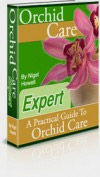Your Orchid Type
Orchid display depends upon the type of orchid you are growing, epiphytes for example are naturally found growing on trees and can look stunning mounted on similar materials indoors. Terrestrial orchid display on the other hand requires you to keep your orchids potted in soil, but don’t feel that this is in any way a lesser option as these types of orchids can look just as stunning as their epiphytic cousins with as many display options available.
Potted Orchids
When you choose to display your orchids in pots it’s important to note that this is an unnatural growing environment for most orchids as the majority of wild orchids are epiphytic. To avoid damaging your orchid remember.
- Use an orchid potting media. Their roots are designed to breathe and absorb water quickly. They are used to being soaked followed by periods of drying, soil will retain to much moisture and prevent air flow around the roots. Good potting media matching your orchids requirements should allow plenty of drainage and airflow.
- Allow for proper drainage. The display pots themselves should allow water to drain quickly. You don’t want your orchids roots to sit in water for lengthy periods of time.
- The conditions of the orchids roots will give you an indication of how healthy your plant is. You can use a clear plastic pot to give you a good view of the roots condition.
Where you choose to locate your orchid display will have a bearing on its health. If it’s growing well in one area make sure you can match the conditions in your new display. As long as you take these things into account you will be able to display your orchid effectively and keep it looking beautifully healthy too.
Mounted Orchids
Common epiphytic orchids include Cattleyas, Vandas, Phalaenopsis and Dendrobiums and can naturally be found clinging to trees, nestled in the crook of a branch or attached to other craggy surfaces that will allow the orchid to get a foothold. These conditions leave the orchids roots exposed allowing for better air flow in their humid environments.
You can simulate these conditions quite easily for free or using specialist display materials such as cork bark or slatted plaques. You’ll find their roots flatten to the display surface over time compared with the rounded shape they have when potted, don’t worry this is natural.
If you choose this method of orchid display then there are a few things you can do to help your orchid along.
- Make sure the display material has an uneven surface for roots to grasp.
- Secure your orchid to the surface for the first year until it has gained a foothold. This can be done with fishing line, string or glue, be sure not to damage the roots though. I prefer fishing line as it’s less visible than string but still easy to remove.
Once your orchid has taken hold the finished display can look stunning.
Wedding Orchids
You’ll often see orchids displayed at weddings and other similar social functions where their elegant flowers and wide choice of colors and delicate blooms make them a popular flower choice for such events. Their displays are mostly pure decoration and not ideal growing conditions. Phalaenopsis and Dendrobiums are two popular species and orchids with white flowers are the obvious choice for weddings although I’ve seen plenty of other colors used effectively also.
Table displays often use cut flowers placed in decorative vases, this avoids visible potting media but this could be easily disguised with a good choice of pot or covered with decorative stones or moss placed around the surface or around the inside of a clear container.
Displaying orchids is as much about imagination as it is about the materials you have available. Learning how to display orchids is simply a matter of trial and error so why not go ahead and try something new.

